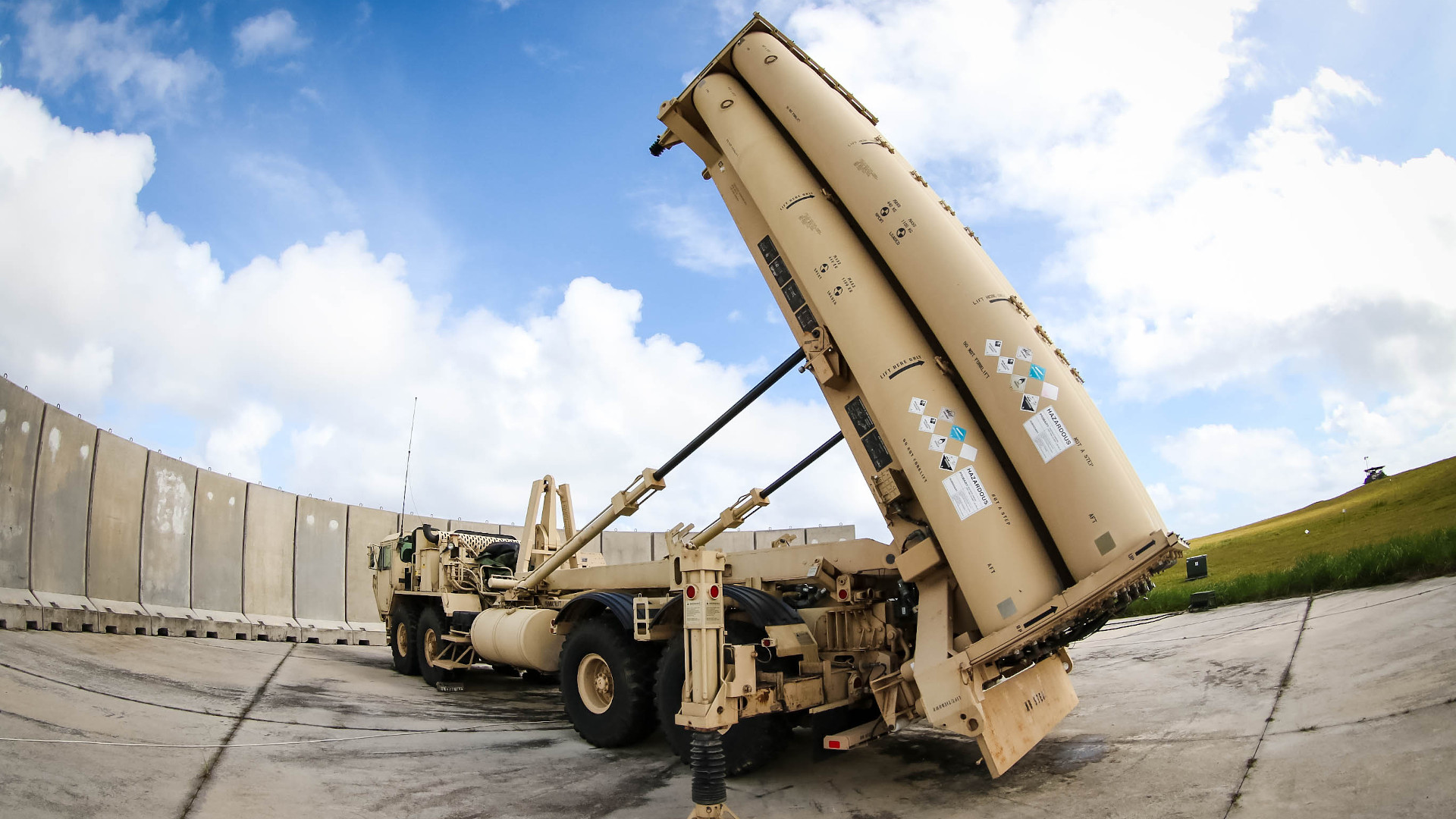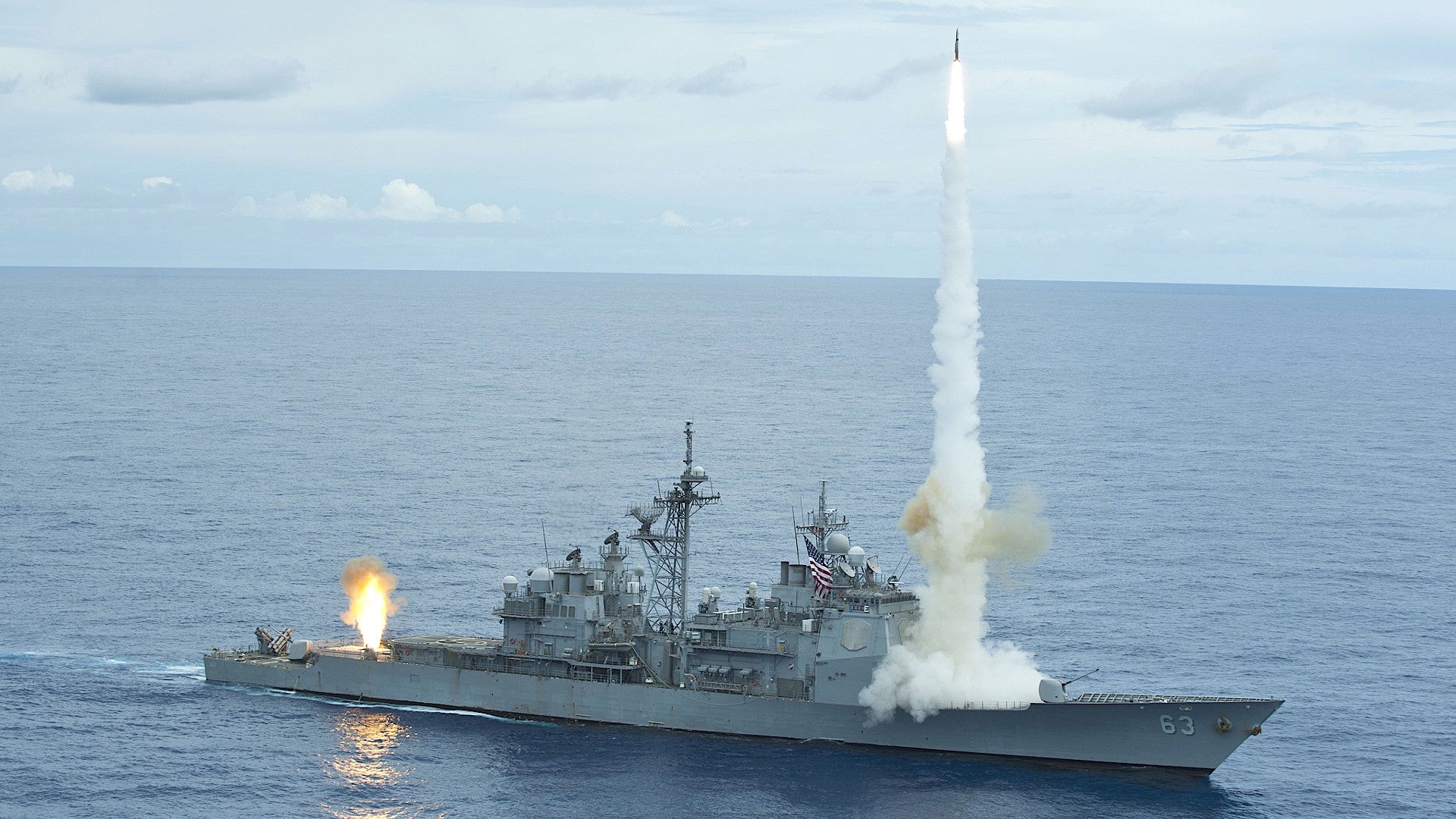The U.S. Army’s experimental deployment of the Israeli-made Iron Dome system to Guam is now underway, with a key focus being on the ability of those defensive assets to protect against incoming cruise missiles, among other threats. At the same time, the U.S. military continues to tackle the vexing question of how it can establish a much broader, layered missile-defense shield around the highly strategic island, and do so quickly, effectively, and affordably. One novel piece of this puzzle may be to repurpose Ticonderoga class cruisers that the U.S. Navy wants to decommission.
Right now, the deployed air- and missile-defense assets on Guam consist of an Army battery equipped with the Terminal High Altitude Area Defense (THAAD) system, designed to intercept certain kinds of ballistic missiles in the terminal stage of flight, as well as the aforementioned Iron Dome unit. The service has stressed this Iron Dome deployment is temporary and that there are no plans to live-fire any interceptors while the system is on the island.

Plans to build on Guam a fixed Aegis Ashore missile-defense site, similar if not identical to the one the U.S. Navy currently operates in Romania, emerged last year. This proposal was prompted in no small part by growing concerns about air and missile threats
China could bring to bear on the island during a potential high-end conflict in the region. However, in March of this year, Navy Vice Adm. Jon Hill, head of the Missile Defense Agency (MDA), said that this kind of above-ground facility might not be able to meet air- and missile-defense demands for the island. Instead, he raised the possibility of building some kind of distributed defense system that could include subterranean and mobile components, as you can read more about here.

In October, MDA submitted a classified report to Congress on potential options for a future Guam Defense System. At the time of writing, publicly available details from this so-called “Architecture Study” remain scant, and no unclassified version has been released.
“Any recommendations for additional studies, including a requirement for only mobile systems, disregard the immediacy and complexity of the threat and the absolute need to integrate fires across the region from a forward multidomain command and control node west of the international dateline,” now-retired Navy Adm. Philip Davidson, then head of U.S. Indo-Pacific Command (INDOPACOM), told members of Congress in March. Davidson was an outspoken advocate for installing an Aegis Ashore system on Guam by 2026 as part of broader plans to deter Chinese aggression in the Pacific.
This is where the Navy’s Ticonderoga class cruisers might come into play. There are presently 21 of these ships in active service, but the Navy outlined plans in its most recent budget request for fiscal year 2022 to retire the seven oldest ones. Each cruiser has an Aegis combat system, along with a powerful AN/SPY-1A/B multifunction radar and 122 Mk 41 Vertical Launch System (VLS) cells capable of accommodating various missiles, including SM-2 and SM-6 surface-to-air missiles and SM-3 anti-ballistic missile interceptors. The SM-2s and SM-6s have secondary capabilities against surface targets. The Navy is also developing an enlarged derivative of the SM-6 that will work with the Mk 41 VLS, which MDA already plans to test as an anti-hypersonic weapon interceptor.

The current standard Aegis Ashore site configuration uses similar components, having been designed to effectively port over the relevant capabilities from the Flight IIA Arleigh Burke class destroyer into a land-based system. These subvariants of the Arleigh Burke design feature an Aegis combat system, an AN/SPY-1D radar, and 96 Mk 41 VLS cells.

So, in effect, just one decommissioned Ticonderoga class cruiser moored in place could provide similar coverage and capacity to a single Aegis Ashore site. Using more than one in this way might provide a cost-effective way to generate even more defensive capacity in the near term.
In August, the Heritage Foundation in Washington, D.C., put out a white paper from Brent Sadler, a Senior Fellow for Naval Warfare and Advanced Technology, laying out exactly how this might work. Sadler noted that three of the seven Ticonderogas the Navy wants to decommission in the coming years — USS Shiloh, Erie, and Port Royal — are equipped with the Aegis Ballistic Missile Defense (BMD) system and would be optimal for this new role. Aegis BMD, combined with certain versions of the SM-3 interceptor and other systems, enables attempted intercepts of larger ballistic missiles, including intercontinental ballistic missiles (IBCMs), during the mid-course portion of their flights, when they are traveling outside of the Earth’s atmosphere.
“The Navy’s rationale for retiring the three BMD-capable cruisers was the high cost of continuing to operate them at sea due to overdue maintenance; especially their fuel tanks, which have been known to leak,” Sadler explained. “Guam offers several protected anchorages that a moored BMD-capable cruiser could move between without having to conduct prolonged navigation. This potentially obviates the need for the Navy to man or maintain these ships for independent at-sea operations — potentially escorted or towed between mooring sites. This would enable putting the ship’s propulsion system in a state of reduced operational readiness and reducing the crew.”
Sadler further pointed out that even with limited mobility, such as a need to be towed from one location to another, that these cruisers with their skeleton crews could be repositioned elsewhere in the region as necessary. These vessels might also retain their ability to launch weapons at targets at sea and on land.

In addition, while Guam with its strategic air and naval facilities is often at the center of discussions about U.S. military power projection in this part of the Pacific, threats to the island have already prompted work to expand infrastructure on the nearby island of Tinian. There have also been efforts to expand partnerships with the independent archipelago nation of Palau to support various defense and security initiatives. Decommissioned Ticonderogas could help protect these islands, as well.
There are still cost questions and other potential hurdles to this plan. “Some of these cruisers have the SPY-1A radar, which is an analog system,” Chief of Naval Operations Adm. Michael Gilday said during a virtual talk in July that the Navy League hosted as part of a lead-in to its annual Sea Air Space conference. “Others are early SPY-1Bs.”

“They’re approaching obsolescence, number one, and, number two, they have difficulty seeing the threat based on the speed and profiles of the threat missiles we see flying these days,” he continued. “The cost alone for cruiser modernization is running tens of millions of dollars above what we originally estimated, largely due to the unknowns related to hulls that are over three decades old.”
The Navy is already paying to develop and field new air and missile defense-capable radars for various ships, as well as new versions of the Aegis combat system, as The War Zone
explored in this feature earlier this year. Lockheed Martin, the company behind Aegis, has specifically proposed using a version of its AN/SPY-7(V)1 Long Range Discrimination Radar (LRDR) as a replacement for the aging variants of the AN/SPY-1 on the Navy’s Ticonderogas.

Moored Ticonderogas would not have the same requirements to operate independently. This raises the possibility that they might not need to rely on any onboard sensors at all to engage threats. Instead, they could be networked together with other assets at sea, on land, in the air, and in space. The Pentagon is already planning to set up an LRDR array in Hawaii and has proposed installing a Tactical Multi-Mission Over-the-Horizon Radar in Palau to provide additional sensor coverage to spot air and missile threats. Another could be installed ashore on Guam. There has also been discussion of establishing a satellite-based radar constellation that could be focused on areas of the Pacific.
Within this context, decommissioned Ticonderogas could potentially be configured as little more than arsenal barges, leveraging their existing VLS capacity as part of a larger, layered defensive posture. Freed from the need to necessarily be positioned in a way that would give onboard sensors the best view of potential avenues of attack, they could be repositioned irregularly. This, in turn, would complicate the ability of enemy forces to target them.
“It’s not new science separating radars from weapons,” MDA’s Adm. Hill had said in March when he brought up the possibility of alternative defense options for Guam beyond a typical Aegis Ashore site. The idea of using “engage on remote” and “launch on remote” concepts for missile defense, wherein some or all of the tracking and targeting data is provided by sources other than the platform launching the actual interceptor, is well established. It may even be essential in many cases to use this kind of networked sensor architecture to ensure threats are spotted and tracked quickly enough for interceptors to be cued at all.
The video below provides a good overview of how a distributed, networked missile defense architecture would be employed, in this case in the context of defeating future hypersonic threats.

Onboard radars and much of the ship’s mission support equipment, along with its main engines and many of its other maintenance-heavy systems and combat accouterments could be removed or abandoned. Command and control, as well as primary sensor systems, would all exist remotely. This could make using these ships to support missile defense of the island and the surrounding region very attractive in terms of price and sustainment costs.
Approval from Congress to use the Ticonderogas in this way might present another pitfall. Lawmakers have almost categorically opposed the retirement of any of these cruisers for any reason for years now, citing the capabilities they still offer and the lack of potential replacements on the horizon. The House Armed Services Committee’s Subcommittee on Seapower and Projection Forces did signal earlier this year that this opposition might finally be waning, though legislators in the House and Senate certainly remain skeptical of the Navy’s plans to fill capability gaps resulting from retiring these ships.
The House Appropriations Committee had separately moved earlier this year to gut all funding in the fiscal year 2022 defense budget for any future Guam Defense System based, at least in part, on outstanding questions about exactly how the Pentagon expected to spend that money. This was why legislators had demanded the October MDA report. The Pentagon’s proposed budget for the next fiscal cycle had asked for approximately $118.3 million to begin development work on new air and missile defenses for Guam.
Repurposing some of the Navy’s aging Ticonderoga class cruisers, which the service already wants to divest, into moored air- and missile-defense stations could certainly offer one path to dramatically expanding the defensive umbrella around Guam in the near term in a way that might appeal to all the stakeholders involved.
Contact the author: joe@thedrive.com
